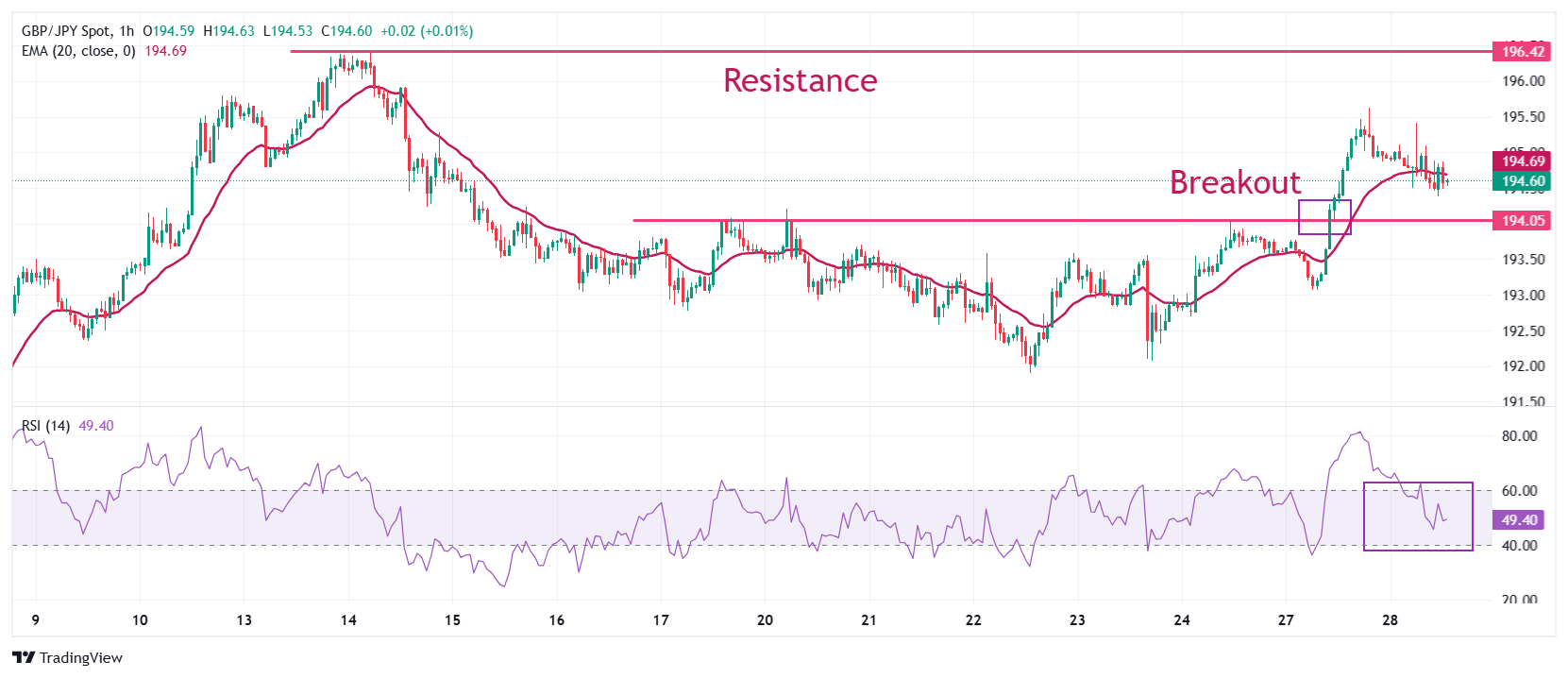GBP/JPY Price Forecast: Sees more upside above 196.50
- GBP/JPY retraces to near 194.50 as the Pound Sterling struggles to extend upside.
- The Japanese Yen gains as likely changes in bond composition this year have prompted a rise in bond yields.
- Traders reassess BoE dovish bets after hot UK inflation and strong Retail Sales data for April.
The GBP/JPY pair corrects to near 194.50 during European trading hours on Wednesday after refreshing an almost two-week high around 195.60 the previous day. The pair faces selling pressure as the Pound Sterling (GBP) underperforms after a strong run-up in the past few trading days.
British Pound PRICE Today
The table below shows the percentage change of British Pound (GBP) against listed major currencies today. British Pound was the weakest against the Japanese Yen.
| USD | EUR | GBP | JPY | CAD | AUD | NZD | CHF | |
|---|---|---|---|---|---|---|---|---|
| USD | 0.09% | 0.02% | -0.14% | 0.07% | -0.02% | -0.37% | 0.00% | |
| EUR | -0.09% | -0.02% | -0.16% | -0.01% | -0.09% | -0.42% | -0.06% | |
| GBP | -0.02% | 0.02% | -0.14% | 0.06% | -0.05% | -0.07% | -0.00% | |
| JPY | 0.14% | 0.16% | 0.14% | 0.20% | 0.11% | -0.21% | 0.22% | |
| CAD | -0.07% | 0.01% | -0.06% | -0.20% | -0.08% | -0.40% | -0.06% | |
| AUD | 0.02% | 0.09% | 0.05% | -0.11% | 0.08% | -0.00% | 0.05% | |
| NZD | 0.37% | 0.42% | 0.07% | 0.21% | 0.40% | 0.00% | 0.05% | |
| CHF | -0.01% | 0.06% | 0.00% | -0.22% | 0.06% | -0.05% | -0.05% |
The heat map shows percentage changes of major currencies against each other. The base currency is picked from the left column, while the quote currency is picked from the top row. For example, if you pick the British Pound from the left column and move along the horizontal line to the US Dollar, the percentage change displayed in the box will represent GBP (base)/USD (quote).
However, the outlook of the Pound Sterling remains firm as traders pare bets supporting the Bank of England (BoE) to reduce interest rates again in the June policy meeting. A hotter-than-projected United Kingdom (UK) Consumer Price Index (CPI) and robust growth in Retail Sales data for April have forced traders to reassess BoE dovish bets.
The data released last week showed that the UK headline CPI accelerated at a faster pace to 3.5% year-over-year, and retail sales expanded strongly by 1.2% month-over-month.
Meanwhile, the Japanese Yen (JPY) performs strongly due to a sharp spike in Japan bond yields in expectations of significant changes in the bond program for the current fiscal year. A report from Reuters on Tuesday showed that Japan's Ministry of Finance will consider tweaking the composition of its bond program, which could involve cuts to its issuance of super-long bonds.
GBP/JPY strengthens after a breakout of the horizontal resistance plotted from the May 19 high of 194.00 on an hourly timeframe. The 50-hour Exponential Moving Average (EMA) is expected to be a key support for the pair around 194.35.
The 14-period Relative Strength Index (RSI) falls into the 40.00-60.00 range after turning overbought above 80.00. A fresh bullish momentum would come into action when the RSI returns above 60.00.
The pair could extend its upside towards the January 7 high of 198.26 and the psychological level of 200.00 after breaking above the four-month high of 196.40.
On the flip side, a downside move by the pair below the May 6 low of 190.33 will expose it to the March 11 low of 188.80, followed by the February 7 low of 187.00.
GBP/JPY hourly chart

Japanese Yen FAQs
The Japanese Yen (JPY) is one of the world’s most traded currencies. Its value is broadly determined by the performance of the Japanese economy, but more specifically by the Bank of Japan’s policy, the differential between Japanese and US bond yields, or risk sentiment among traders, among other factors.
One of the Bank of Japan’s mandates is currency control, so its moves are key for the Yen. The BoJ has directly intervened in currency markets sometimes, generally to lower the value of the Yen, although it refrains from doing it often due to political concerns of its main trading partners. The BoJ ultra-loose monetary policy between 2013 and 2024 caused the Yen to depreciate against its main currency peers due to an increasing policy divergence between the Bank of Japan and other main central banks. More recently, the gradually unwinding of this ultra-loose policy has given some support to the Yen.
Over the last decade, the BoJ’s stance of sticking to ultra-loose monetary policy has led to a widening policy divergence with other central banks, particularly with the US Federal Reserve. This supported a widening of the differential between the 10-year US and Japanese bonds, which favored the US Dollar against the Japanese Yen. The BoJ decision in 2024 to gradually abandon the ultra-loose policy, coupled with interest-rate cuts in other major central banks, is narrowing this differential.
The Japanese Yen is often seen as a safe-haven investment. This means that in times of market stress, investors are more likely to put their money in the Japanese currency due to its supposed reliability and stability. Turbulent times are likely to strengthen the Yen’s value against other currencies seen as more risky to invest in.

